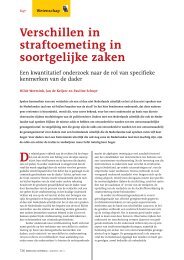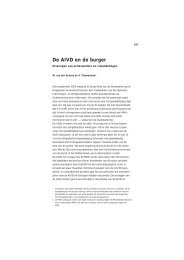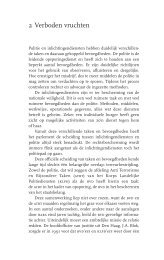Biometrics - Buro Jansen & Janssen
Biometrics - Buro Jansen & Janssen
Biometrics - Buro Jansen & Janssen
Create successful ePaper yourself
Turn your PDF publications into a flip-book with our unique Google optimized e-Paper software.
4 Methodology<br />
4.1 Qualitative Research<br />
Qualitative research is an investigative methodology. It involves an in‐depth,<br />
comprehensive understanding of human behaviour and the reasons that govern human<br />
behaviour. It tries to investigate the why and how of decision making and tries to<br />
understand peopleʹs interpretations [Key, J.P., Oklahoma State University, 1997]. Therefore<br />
when conducting qualitative research a smaller and focused samples are required. Detailed<br />
data is gathered usually through open‐ended questions that provide direct quotations. The<br />
human is the primary collection instrument. The interviewer is an integral part of the<br />
research. Research is usually conducted in the natural environment under natural<br />
conditions. Data derived from these case studies are then categorised into patterns, a way<br />
to organise and report results. When conducting a qualitative research, one seeks a wide<br />
understanding of the entire situation. During the research different theories evolve. The<br />
idea behind qualitative research is to gain ʹrealʹ, ʹrichʹ, and ʹdeepʹ data. Data gathered from<br />
qualitative research are perceptions of the people in a certain setting.<br />
4.2 Case Studies<br />
Case studies are detailed investigations of individuals, groups, institutions or other social<br />
units. When a researcher decided to analyse a case study, one focuses on an individual case<br />
and not the whole population of cases. The focus doesnʹt lie on generalisation, but on<br />
understanding the particulars of the case. A case study focuses within a certain frame,<br />
usually under natural conditions, so that the system can be understood in its own<br />
circumstances.<br />
4.3 Empirical Research<br />
When I started with my research, I firstly decided my cases studies. I had read several<br />
articles about recent developments regarding biometric technologies in public spaces.<br />
<strong>Biometrics</strong> are implemented in various places, but mostly one encounters these<br />
technologies in private companies. These case studies are particularly interesting, since<br />
they are the first public spaces in the Netherlands, where biometric technologies have been<br />
set up for security reasons. All three case studies have been heavily represented and<br />
publicised in the media. In total I chose three case studies.<br />
My case studies concern three different settings:<br />
1. A disco in Puttershoek, where a finger scan and face scan are taken<br />
2. A swimming pool in Ridderkerk, where they also use the same biometric technology at<br />
the entrance<br />
3. A disco in Rotterdam, where VIP – members can implant a RFID ‐tag in their bodies<br />
39

















